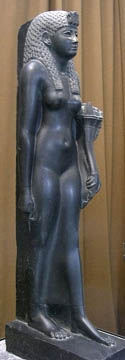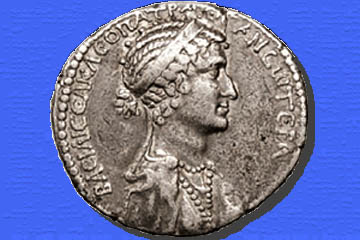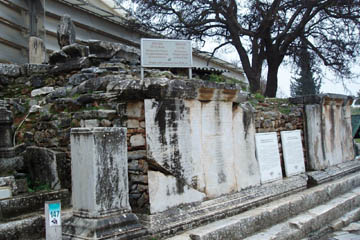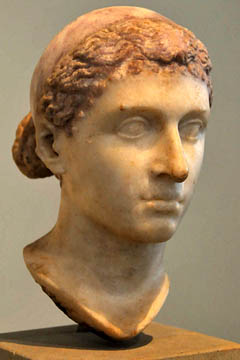What goes round ...
The expression "what goes around comes around" means that what you do to others has a nasty habit of rebounding on your own head, a popular assertion of the doctrine of karma - that the bad things you do in one life have to be paid for in your next life. People may scoff at the idea - and I certainly don't believe in multiple lives - but it is certainly true that the good or bad that we do has a way of coming back to us. Try smiling at strangers and you'll find that most of them will smile back at you; frown angrily and risk not only frowns in return but a reputation as an unpleasant curmudgeon.

| |
| A statue of Cleopatra from the Hermitage Museum. |
Nowhere is this more clearly seen than in people with ambition. I'm not talking about the the gentle ambition to be the best at building kites or collecting stamps, nor even the irrational ambition to get in the Guiness Book of Records for sitting in a cage of scorpions or something equally mad. No, I'm talking about the ambition to be the richest or the most powerful, and in achieving your aim you trample on everyone, exploit everyone, disparage and dennigrate your rivals, until finally you are up there on the top. Likely by that time you have no friends left and when things start going wrong there is no one to help you when equally ambitious rivals stamp all over you.
When Ptolemy XII the Flute-player died in 51 BC he left his kingdom to his eldest son, Ptolemy XIII, who was twelve. The trouble was that by this time the Ptolemies were thoroughly Egyptianised and according to Egyptian custom the right to the throne descended in the female line, which is why so many pharaohs married their sisters. Ptolemy XII had an eighteen year old daughter by his first wife called Cleopatra - the seventh of that name - whom he had made his co-regent. He married her to her half-brother and instructed that they should share power equally.
Given a bit of give-and-take, the arrangement might have worked, but the trouble was that Cleopatra VII had been hoping to become sole ruler on her father's death and was by no means enamoured of her younger half-brother. Ignoring the Ptolemaic tradition that women were subordinate to men, she issued coins bearing only her own image and official documents made no mention of Ptolemy.

| |
| A silver coin of 36 BC. Note Cleopatra's famous nose. |
Whether the young boy to whom she was married would have swallowed the insult we can't know, but his advisers led by the eunuch Pothinus were just as eager for their protege to have the supreme power and within two years had engineered a coup that saw Cleopatra fleeing for her life accompanied by her half-sister Arsinoe. Despite raising an army, Cleopatra's cause faltered and might have failed if Ptolemy XIII had not made a fatal mistake.
Late in 48 BC the Roman general Pompey came to Egypt seeking refuge and a loan after his defeat by the forces led by Julius Caesar. Ptolemy lured him ashore with promises of help and as soon as he reached land had him murdered. A few days later Julius Caesar arrived and Ptolemy presented him with his rival's head - only to be astonished when Caesar was disgusted and enraged by the murder of a Roman consul.
We don't know whether Cleopatra learned of Caesar's anger or whether she just determined to try a bold ploy, but a few days later one of her servants brought a rolled up carpet to Caesar as a gift. When the carpet was unrolled a somewhat dizzy Cleopatra staggered to her feet and faced the man who was de facto ruler of Egypt. She was 21 and he was 52. Some claim that Cleopatra was naked, but even if she was clothed, Egyptian linen was notoriously transparent and throughout his life Caesar had shown considerable susceptibility to female charms. The two became lovers and Ptolemy XIII, who could not hope to compete against his sister's attractions, was put under arrest - the treacherous Pothinus was executed.

| |
| A not terribly convincing computer-aided reconstruction of what Arsinoe may have looked like. (I doubt she wore pink lipstick!) |
Arsinoe took advantage of the confusion to escape from Alexandria and went straight to Ptolemy's army, where she declared herself pharaoh as Arsinoe IV. When the army general objected to her arrogant ways she had him killed and installed her tutor, Ganymedes, as army commander. He won some initial successes against the Romans but offended the professional officers of the army who quietly arranged with the Romans to exchange Arsinoe for Ptolemy, pretending that they wanted peace. Once Ptolemy was free, however, they enthusiastically worked with him to continue the war until they were decisively defeated in January, 47 BC, and Ptolemy conveniently drowned in the Nile while on his way to surrender negotiations.
Of course people were as hypocritically keen on the conventions of society in those days as they are today, and Cleopatra promptly married her remaining half-brother, Ptolemy XIV, even though everyone knew that she was Caesar's mistress and was carrying his child. Nine months after their first meeting, she gave birth to a son and called him Ptolemy XV, though everyone knew him as Caesarion - "little caesar".
Arsinoe was taken back to Rome and forced to march in chains in Caesar's triumphal procession. It was the custom that high-ranking prisoners were taken to the Capitol after the procession and strangled, but Caesar had better uses for a pretty woman and grandly granted her pardon. She was allowed to slip away to Ephesus and take refuge in the temple of Artemis there. The chief priest, Megabyzus, welcomed her as Queen of Egypt, a mistake he was later to regret.
Cleopatra must have been profoundly annoyed when Julius named his grand-nephew Octavian as his heir instead of Caesarion. We have no idea of her feelings when, three years after Caesarion's birth, Julius was assassinated in the Senate House in Rome. We do know, however, that Ptolemy XIV died almost immediately after the news reached Egypt and it is virtually certain that he was poisoned by his nominal wife. Cleopatra elevated her three year old son to the position of co-regent.

| |
| The Octagonal Monument in Ephesus, thought to be the tomb of Arsinoe. |
Two years later Antony, in pursuit of Caesar's killers, arrived in Tarsus and summoned Cleopatra to give an account of herself to him. She arrived in a magnificent ship decorated with saffron sails and with small boys dressed like cupids in the rigging. That transparent linen dress got another outing and the result was that the following year she presented Antony with twins, Alexander Helios and Cleopatra Selene II. She also took advantage of his infatuation to have Arsinoe put to death and on Antony's orders a band of Roman soldiers dragged her out of the temple and murdered her on its steps. Megabyzus was arrested and only pardoned when the citizens of Ephesus sent a delegation to beg his pardon from Cleopatra herself.
By then Antony was far away battling the Parthians, who had supported Brutus and Cassius (there were actually Parthian troops on the battlefield of Philippi) and had subsequently invaded the Roman east, capturing Jerusalem and expelling the Roman nominee, Herod. When Octavian failed to provide him with enough soldiers for the war against Parthia, Antony travelled to Egypt and appealed to Cleopatra, who gave him large sums of money and also a second son, Ptolemy Philadelphus.
Unfortunately Antony's big invasion of Parthia was a disaster and he returned, defeated, to Egypt where he married Cleopatra and settled down to being monarch of the east. His children were crowned as kings of Armenia, Cilicia, Parthia and various other places, but these empty titles did no more than offend the people who were already rulers of those countries and lose Antony even more support. Meanwhile Octavian was manoeuvring skilfully in Rome and winning political support there, where it really mattered.
The disastrous Battle of Actium in 31 BC meant the end for Antony and also for Cleopatra, who had hoped to rule the world through him. The pair fled back to Egypt where Octavian arrived shortly after. Cleopatra made a last attempt to keep her power but her transparent dress had lost its magic and she retired to a massive free-standing tomb and bolted the doors. Antony stabbed himself but failed to hit anything vital and was carried to the tomb where the women refused to open the doors and he was hauled up by ropes. The ordeal reopened his wound and he died shortly afterwards. Cleopatra had a poisonous snake, an asp, smuggled in to her in a basket of figs and provoked it to bite her.

| |
| The 'Berlin Cleopatra' possibly made when she visited Rome. The nose is restored. |
Octavian, who had been hoping to have the famous queen march in his triumphal procession, was seriously annoyed and when the Egyptians proclaimed Caesarion pharaoh as Ptolemy XV he was even less pleased. Remarking that "Two Caesars are one too many", he ordered the boy's death. Caesarion was smuggled away by his tutor and the pair headed for the Red Sea port of Berenike, perhaps intending to take refuge in Parthia or India, but they were caught and Caesarion was strangled.
Antony's three children by Cleopatra were taken back to Rome, where they appeared in Octavian's triumphal procession, so loaded down with gold chains that they could not move. Afterwards, however, they were handed over to Antony's wife, who brought them up. The two boys appear to have died as children, but Cleopatra Selene survived to be married by Octavian to King Juba of Mauritania.
In 1926 the excavators of Ephesus discovered an octagonal monument in the centre of the city. On stylistic grounds the badly ruined building was dated to 50-20 BC. When they explored the tomb chamber beneath the monument they discovered the bones of a young woman, perhaps 18 to 20 years of age. They removed the skull - why, I am not sure - and measured it before storing it safely away. Unfortunately, during the upheavals of the Second World War when work at Ephesus was suspended, the skull disappeared.
About fifteen years ago Hilke Thuer of the Austrian Academy of Sciences decided to re-examine the tomb. Despite the fact that there is an octagonal tomb at Pula, in Istria, she decided that the fact that the monument was octagonal was a clear link to the Pharos of Alexandria and on this basis concluded that it might be the the tomb of Arsinoe. The headless skeleton was still in place and was removed for examination by Professor Kanz, who has examined more than 500 other skeletons from Ephesus, including the recently discovered gladiators.
His conclusion was that the skeleton was female and aged between 15 and 18. This is possibly a bit young for Arsinoe, though not impossibly so. Cleopatra herself was only 27 at the time of Arsinoe's murder. There was no sign of disease or malnutrition, which could point to a violent death - though many fatal diseases such as typhoid or cholera do not leave traces on the bones. The proportions of the skeleton were consistent with a north African origin.
Despite the absence of the missing skull, a forensic anthropologist called Caroline Wilkinson used modern computer techniques to make a reconstruction based on the measurements and two photographs made in 1926. While questions must remain about the accuracy of the reconstruction - particularly as the jaw was missing and could only be guessed at based on estimates of the tendons and muscles attached to the upper part of the skull. As a result even more doubt must be expressed over the computer-generated facial reconstruction that purports to show what Arsinoe looked like. About all that can be said is that she had a long head which is typical of ancient Egyptians and black Africans.
Of course, this accords with the tradition that Cleopatra's mother, Cleopatra V, had African blood. Could this be the secret of Cleopatra's charm? Plutarch, in his Life of Antony describes her like this:
"For her beauty, as we are told, was in itself not altogether incomparable, nor such as to strike those who saw her; but conversation with her had an irresistible charm, and her presence, combined with the persuasiveness of her discourse and the character which was somehow diffused about her behaviour towards others, had something stimulating about it. There was sweetness also in the tones of her voice; and her tongue, like an instrument of many strings, she could readily turn to whatever language she pleased."
None of the depictions of Cleopatra, whether Egyptian or Roman statues or on coins, show her with negroid features, but she may well have had dusky skin and curly hair. Such characteristics might explain why Plutarch thought her not altogether beautiful but may well have been novel and irresistable to a less impartial observer - that is, someone whose attention was on the transparent dress rather than the face.
Dr Fabian Kanz, of the Medical University of Vienna, will present a scientific paper on the remains at the Americna ASsociation of Physical Anthropologists in Chicago in March, 2009 and no doubt he will talk about the size and weight of the bones, of the features of the face and the build of the body, but I doubt he will say a word about the overweening ambition that brought all these people to an untimely end. Such things don't show up in bones.
© Kendall K. Down 2009





